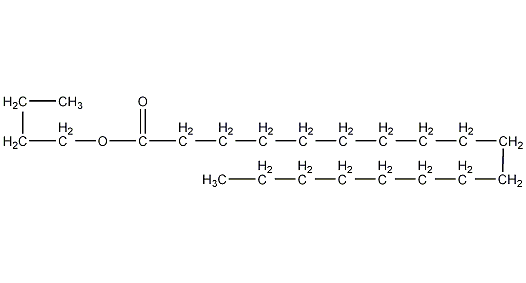
Structural formula
| Business number | 03HG |
|---|---|
| Molecular formula | C22H44O2 |
| Molecular weight | 340.59 |
| label |
n-Butyl octadecanoate, Butyl stearate, n-Butyl stearate, Butyl stearate, Butyl octadecanoate, Butyl octadecanoate, Butyl stearate, lubricants, waterproofing agent, Base material for cosmetics, shoe polish gloss agent, plasticizer, Release agent |
Numbering system
CAS number:123-95-5
MDL number:MFCD00026669
EINECS number:204-666-5
RTECS number:WI2900000
BRN number:1792866
PubChem number:24899626
Physical property data
1. Properties: The pure product is white crystal, usually colorless or slightly yellow waxy solid or liquid.
2. Boiling point (ºC, 101.3kPa): 222~225
3. Melting point (ºC): 27.5
4. Relative density (g/mL , 20/4ºC): 0.860
5. Refractive index (20ºC): 1.4456
6. Viscosity (mPa·s, 25ºC): 8.26
7 . Flash point (ºC, closed): 160
8. Flash point (ºC, open): 187.8
9. Fire point (ºC): 355
10. Heat of evaporation (KJ/kg): 100.1
11. Conductivity (S/m, 30ºC): 2.1×10-13
12 . Vapor pressure (kPa, 20ºC): 0.17×10-6
13. Volume expansion coefficient (K-1): 0.00083
14. Solubility: Miscible with mineral oil and vegetable oil, soluble in ethanol and ether, slightly soluble in water.
Toxicological data
1. Skin/eye irritation: Human skin standard Drez eye dye test: 500mg/24H has a moderate irritating effect on the skin.
2. Acute toxicity: rat oral LD50: 32gm/kg
with with transperitoneal cavity LD50: 32gm/kg
:>32gm/kg
3. Reproductive toxicity: rats (male, mated)��10 days) Oral TDLO: 418gm/kg/10W
4. It is slightly toxic. The oral LD50 in rats is 32g/kg. Rats fed diets containing 1.25% and 6.25% butyl stearate showed no adverse effects for two years.
Ecological data
This substance may be harmful to the environment and special attention should be paid to water bodies.
Molecular structure data
1. Molar refractive index: 105.1
2. Molar volume (cm3/mol): 395.1
3. Isotonic specific volume (90.2K ): 932.1
4. Surface tension (dyne/cm): 30.9
5. Polarizability (10-24cm3): 41.92
Compute chemical data
1. Reference value for hydrophobic parameter calculation (XlogP): 9.8
2. Number of hydrogen bond donors: 0
3. Number of hydrogen bond acceptors: 2
4. Number of rotatable chemical bonds: 20
5. Number of tautomers: none
6. Topological molecule polar surface area 26.3
7. Number of heavy atoms: 24
8. Surface charge: 0
9. Complexity: 250
10. Number of isotope atoms: 0
11. Determine the number of atomic stereocenters: 0
12. Uncertain number of atomic stereocenters: 0
13. Determine the number of chemical bond stereocenters: 0
14. Number of uncertain chemical bond stereocenters: 0
15. Number of covalent bond units: 1
Properties and stability
1. Soluble in most organic solvents, hardly soluble or slightly soluble in glycerol, ethylene glycol, methanol and certain amines. The chemical properties are relatively stable and not easy to hydrolyze. But it can be hydrolyzed in the presence of caustic alkali.
Storage method
Packed in galvanized iron drum. Store in a dry and cool place. Keep away from fire and heat sources. Protect from sun, moisture, etc. during transportation. They are not dangerous goods.
Synthesis method
1. Add 250kg stearic acid and 86kg butanol into an esterification kettle with stirring and equipped with a condenser and water separation device, heat to dissolve, and then add 1.5kg 98% concentrated sulfuric acid while stirring. Continue to heat to 105~110℃, the materials in the kettle reach boiling, react for 6~8 hours, the escaping butanol, water and other vapors are condensed into liquid through the condenser and enter the water separator, the oil layer flows back into the kettle, and the water layer is released and measured. Check the amount of separated water to determine whether esterification is complete. After the esterification reaction reaches the end point, the material is sent to the vacuum distillation tower, first dehydrated, and then the fraction before 150℃/2666Pa is recovered to obtain butanol for recycling. Then send the kettle liquid into a water washing tank, wash it with water at 50-60°C until it is neutral, let it stand to separate the water layer, then send the organic layer to the distillation device, heat it to 100°C under vacuum to further remove the water, and get Finished product.

Refining method: boiling point below 100℃ Refined by recrystallization in solvent. The acidic impurities contained are neutralized with 0.05mol/L sodium hydroxide solution or 2% sodium bicarbonate solution, and then washed with water to remove them.
Purpose
1. This product is used as an internal lubricant when processing various resins. It is non-toxic, waterproof and has good thermal stability. It is mainly used for transparent soft and hard extrusion, injection molding and calendered products of polyvinyl chloride, with a dosage of 0.5 to 1 part. This product is also very effective in processing modified vinyl chloride-vinyl acetate copolymer, polystyrene, nitrile rubber, etc. It can also be used as a lubricant, waterproofing agent for fabrics, an additive for lubricants, and a base material for cosmetics. It is used as a plasticizer for chemical fibers, plastics and rubber, a release agent and lubricant for various resin molding processes, a lubricant for metals, a waterproofing agent for concrete and fabrics, a shoe polish gloss agent and cosmetics, etc.
2.Butyl stearate is not only an ideal cosmetic raw material, but also an important chemical raw material. It can be used as an adhesive It is a compounding agent, metal processing lubricant, resin additive, deep defoaming agent, plasticizer for rubber and polyolefin resin, and is also a component of concrete moisture-proof agent and polishing agent. It is also very effective in improving the processing properties of vinyl chloride-vinyl acetate copolymer, polystyrene, nitrile rubber, etc.
3.Used in lipstick manufacturing. As a co-solvent to improve the solubility of dyes such as eosinic acid, and as an additive in beauty cosmetics, it is also used as a softener for chemical fibers, plastics, rubber, etc., and as a lubricant.

 微信扫一扫打赏
微信扫一扫打赏

